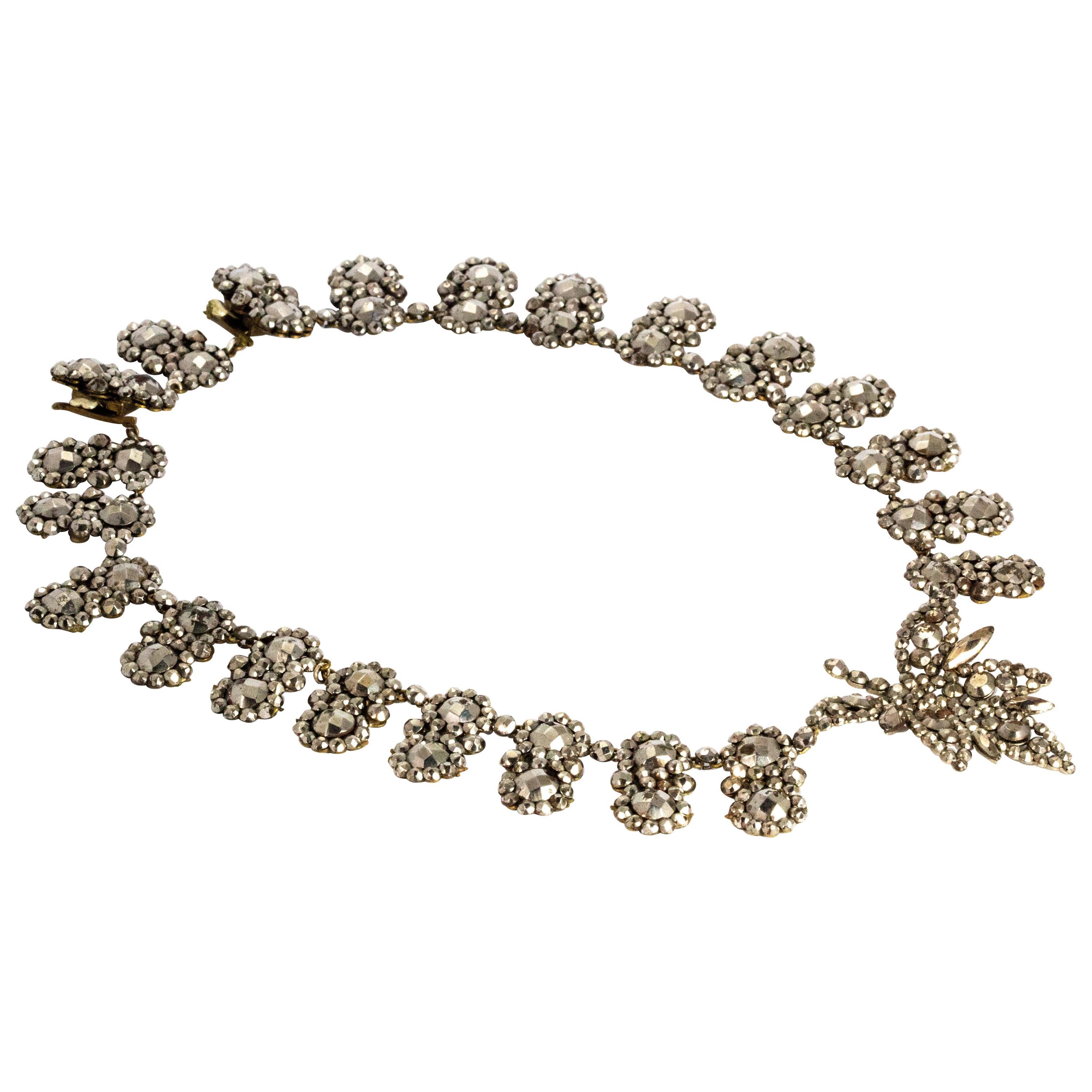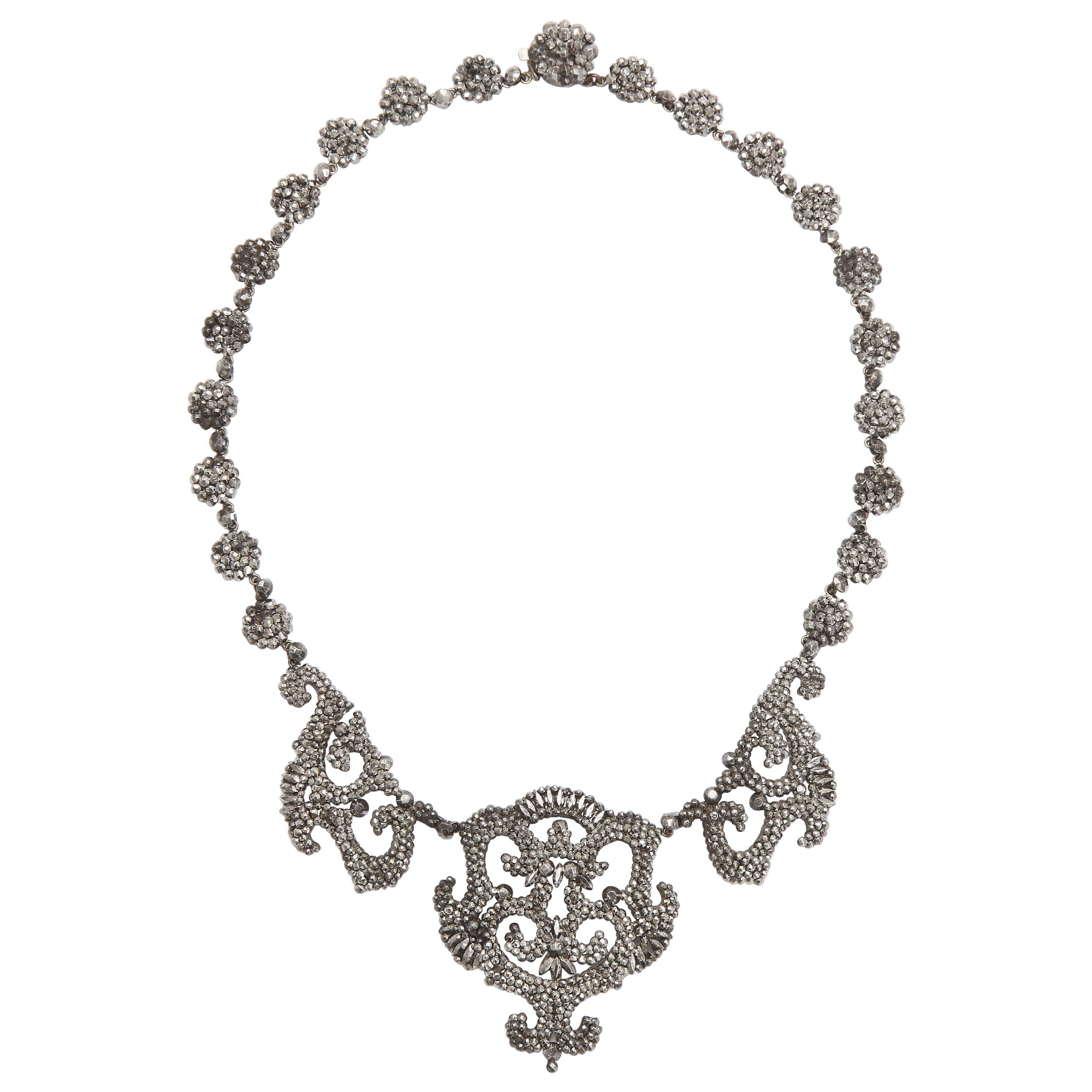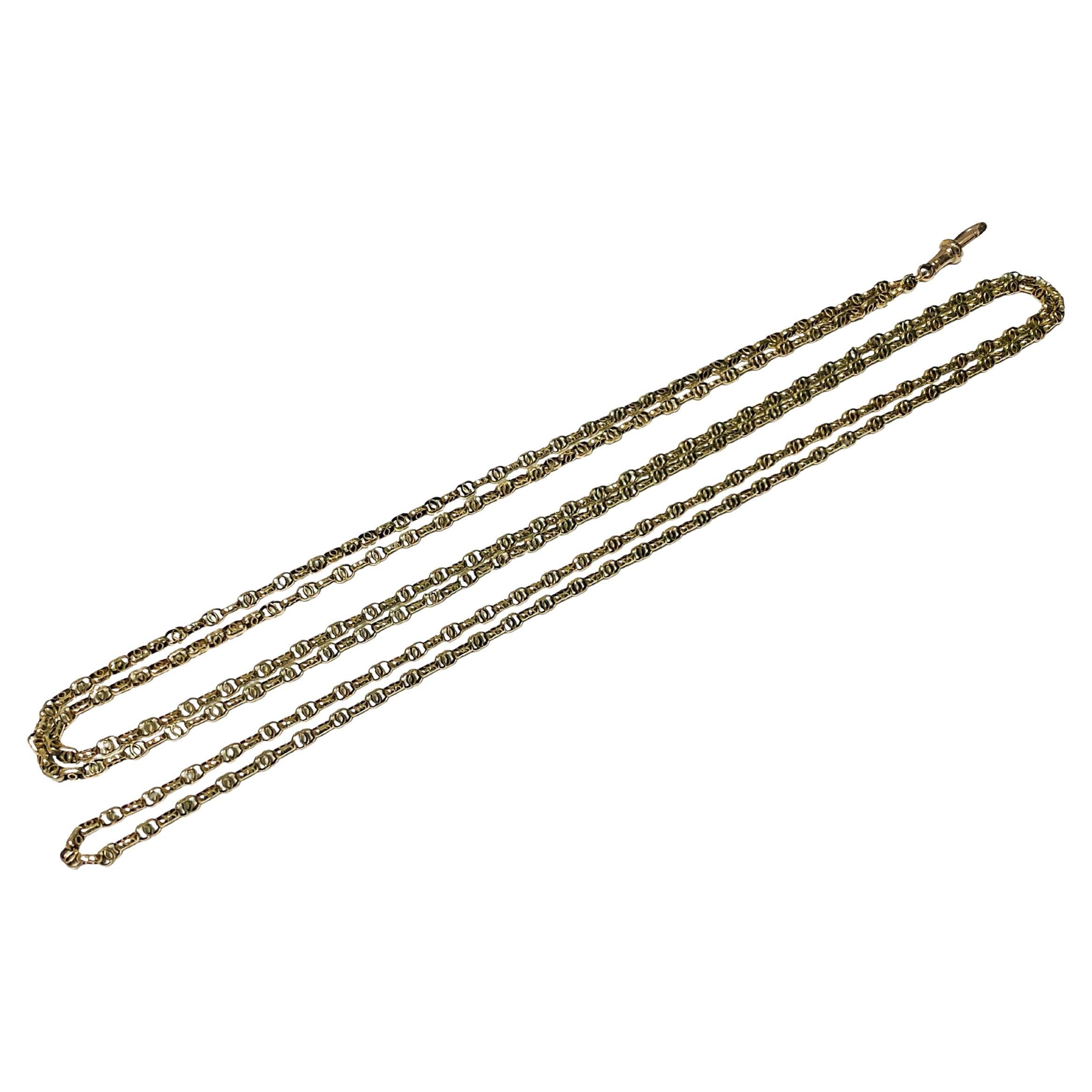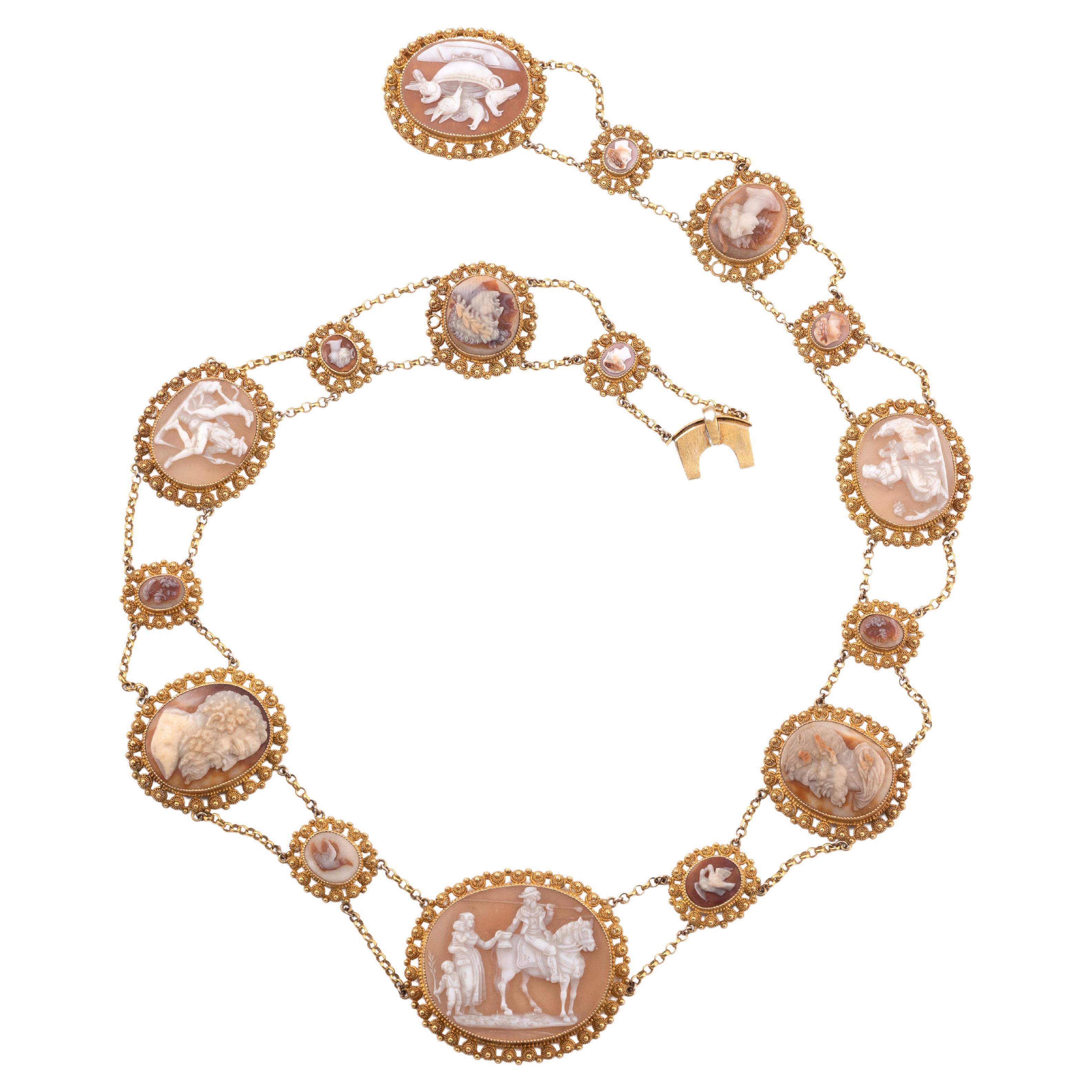Items Similar to Antique Early 19th Century Cut-Steel Necklace
Want more images or videos?
Request additional images or videos from the seller
1 of 7
Antique Early 19th Century Cut-Steel Necklace
About the Item
Cut steel jewelry was at the height of fashion from the mid 1700s well into the 19th century.
Originated in the 1700s. Popular from the Georgian through the Victorian eras. To make cut steel, melted horseshoe nails were formed into tiny faceted beads. Those small steel gemstone-like studs were then riveted one-by-one onto a base plate. It was an English invention that quickly travelled throughout the world. Each stud could have up to 15 facets, and in general the finer and older the piece the more facets the studs will have.
Improvements in candles meant that grand events and entertaining could take place at night. As diamonds are diamonds and not available for everyone, and everyone wanted to shine, the popularity grew. Cut-steel provided a stylish and popular new jewelry material that could be enjoyed by everyone at all levels of society. It grew beyond a simple imitation to an art in its own right. The manufacturing was complex and the workmanship that was required highly skilled. These were not mass produced objects.
The studs were made from decarbonated cast steel, which was case-hardened, then the studs were faceted by cutting against a pewter wheel. Next were then polished with first fine emery and a hard brush, and then by hand with a special putty. Finally they were riveted onto pierced base plates which had to be drilled and cut by hand, too.
The main place of cut steel production was Birmingham, England. And there, one manufacturer stood out from all the rest: Matthew Boulton. He had been born in 1728 into the industry — his father manufactured small metal products. But the younger Boulton had a special talent for marrying the latest technology with the latest fashion. He also was continually expanding — he even founded a mint. He wined and dined with dignitaries and advocated for his steel products. Fortuitously, he became quite close with the Russian ambassador to Catherine the Great. When the ambassador toured the mint, Boulton made sure to send the Empress some of his cut-steel necklaces.
In 1759, Louis XV “encouraged” the nobility to donate their gold and gemstone jewelry to help fund the Seven Years War. The popularity of cut steel in France may in part have been due to these sumptuary laws which limited who could wear precious metals and diamonds. Either you complied with the law and gave up your family jewels to be melted down for the war chest, or you quietly hid your jewelry until the war was over. But you certainly weren’t seen wearing your fanciest ornaments — that would be unpatriotic. Cut steel jewelry, made of non-precious metal, was perfectly positioned to fill that bling gap. Manufacturers pivoted by creating more intricate cut steel jewelry. And the jewels got bigger and more elaborate.
Napoleon was a fan of the style, which certainly played a part in the longevity and popularity of cut steel. In 1810, he gifted a cut steel parure to his second wife, Marie Louise, upon their marriage. (In reality, he couldn’t afford a gemstone parure!). Cut steel jewelry became the staple of any fashionable lady’s evening wear ensemble. These dark, glimmering pieces give off a diamond-like shine that was and still is particularly effective in low lighting, which at the time was candlelight.
The style was so popular and in demand that at the peak of the trend, a fine piece of cut steel jewelry could command a higher price than gold. Silver jewelry was even made to resemble cut steel. The imitation became imitated.
Developments in technology toward the mid to late 19th century made it possible to produce these glittering steel elements by machine, making them more affordable and accessible — but by the early 20th century people had moved on to other jewelry trends. A look at the construction of the rivets, facets and baseplate will tell you if your cut steel piece was made in the early days of the trend, when everything was constructed painstakingly by hand, or later on using machine-made shortcuts.
Unfortunately, as a result of steel’s high corrosion factor, not many pieces have survived.
Producing a remarkable brilliance. Steel has an alluring appeal with its distinct gray blue coloration and catches the light from a myriad of angles. It is no wonder it has become so collectible and prized highly sought after today.
Elegant articulated steel necklace, composed of a stylizing drop of links flowers. It is embellished with an invisible ratchet clasp. Work probably English from the first half of the 19th century Length: 47.5 cm. In great condition, only 2 small studs missing.
- Metal:
- Dimensions:Length: 18.71 in (475 mm)
- Style:
- Place of Origin:
- Period:
- Date of Manufacture:First half of 19th century
- Condition:Wear consistent with age and use. Minor losses. 2 small studs missing, minor signs of rust.
- Seller Location:Malmö, SE
- Reference Number:1stDibs: LU3148218998822

About the Seller
5.0
Recognized Seller
These prestigious sellers are industry leaders and represent the highest echelon for item quality and design.
Platinum Seller
These expertly vetted sellers are 1stDibs' most experienced sellers and are rated highest by our customers.
Established in 2015
1stDibs seller since 2022
31 sales on 1stDibs
Typical response time: 1 hour
- ShippingRetrieving quote...Ships From: Malmö, Sweden
- Return PolicyA return for this item may be initiated within 3 days of delivery.
More From This SellerView All
- Antique early 20th century opal bead and pearl necklaceLocated in Malmö, SE42 beautiful, gently graduated, multi-chromatic opal beads imbued with lightening flashes, alternate with small even sized pearls to create this enchanting necklace. The beads are ra...Category
Antique 1890s European Late Victorian Beaded Necklaces
MaterialsOpal, Pearl, 18k Gold, Platinum
- Antique victorian yellow gold collar necklaceLocated in Malmö, SEA special and very modernistic design for a Victorian piece! Antique collar necklace in yellow 14 karat gold. Unmarked, lenght of necklace 39.0cm, weight 25.3 gramCategory
Early 20th Century English Late Victorian Pendant Necklaces
MaterialsGold, Yellow Gold, 14k Gold
- 19th century onyx and diamond pendant earringsLocated in Malmö, SEA pair of late 19th century onyx and diamond pendant earrings. Super elegant! Each elongated onyx drop highlighted with a rose-cut di...Category
Antique Late 19th Century Drop Earrings
MaterialsDiamond, Onyx, Gold, Silver
- A 19th century diamond and zircon rose broochLocated in Malmö, SEWhen the line between want and need becomes quite blurry. A 19th century 18 karat rose brooch set with an approx. 5ct blue zircon surrounded by 269 antique, old, table and rose cut ...Category
Antique Late 19th Century European Victorian Brooches
MaterialsDiamond, Zircon, 18k Gold, Yellow Gold, Silver
- Bulgari 'Monete' gold Necklace, circa 1980By BulgariLocated in Malmö, SEFrom the Italian Icon – Bvlgari – not only gorgeous and a stunning look, they also show cultural heritage and are interesting pieces of history that make great conversation pieces. We had the pleasure of selling a few different pieces from the collection during the years and just adore the style! It feels as good as it looks. Wearability is always key for Bvlgari and the result is a piece you will want to wear all day! Beyond chic. Rare 1980ies original fitted red leather box! Emperor Publius Septimius Geta. Born on 7th of March 189, 1835 years ago. He succeeded his father who intended for his two sons to rule together, however they proved incapable of sharing power. Geta´s rule was short. Four years passed before Geta was murdered by his brother while in their mothers arms. The brother who refused to share power and rule with Geta then ordered "damnatio memoriae", that Getas portrait and memory be erased from history. 20 000 of his followers is believed to have been murdered in the following purge. Very few portraits of Geta remain today. The necklace is 40,5cm long (15 ¹⁵/₁₆ In), 105.9gram, Back engraved GETA 209 - 213 D.C., original fitted case (rare). Never seen one with this kind of chain, the most common type is the curblink, so if you are looking for a unique one-of-a-kind collectors piece look no further! The coin really pops! Bulgari’s Monete collection is flush with cultural currency. – “Reaching back through the centuries, Bulgari honors antiquity with Monete. Revering the artistic coins of yore. Bulgari contrasts them with the brilliance of its modern style.” Like a rare gem of inestimable historical value this ancient Roman coin has found a new life as precious jewel. The use of rare coins reflected Bulgari’s commitment to honoring history—any irregularities or signs of wear were preserved. Monete pieces date back to the 1960s, when Rome was the epicenter of glamour - the so called “La Dolce Vita” era. During this time Bulgari began to make Monete a feature of the house’s narrative. Evoking Bulgari’s artisanal craftsmanship, avant-garde materials and unrivalled design as a stylish way to reference the family’s Greek and Roman roots. Both Grace Kelly and Elisabeth Taylor...Category
Vintage 1980s Italian Modern Link Necklaces
MaterialsGold, 18k Gold, Yellow Gold
- Antique early 20th century silver and paste lizard salamander broochLocated in Malmö, SEA fine antique early 20th century paste lizard or salamander brooch, artfully and expertly handcrafted in silver, partly gilt, workmanship c. 1900, in a fitted case, with the cutest ...Category
Early 20th Century English Victorian Brooches
MaterialsSilver
You May Also Like
- Mid-19th Century Cut Steel NecklaceLocated in Chipping Campden, GBAny fan of cut steel would be unbelievably happy with this piece, it is in lovely condition and the reflective links are mesmerising! The detailed centre panel is a decorative leaf w...Category
Antique Mid-19th Century British Victorian More Necklaces
MaterialsCut Steel
- Antique Georgian1820s Early Cut Steel NecklaceLocated in Stamford, CTA crowning glory of design, this cut steel necklace shimmers like diamonds, in available light as it did originally in the early 1800's. Serves dressy occasions or denim shirts and b...Category
Antique Early 18th Century British George IV Link Necklaces
MaterialsCut Steel
- Antique 19th Century Muff Chain, English circa 1890Located in Toronto, ONAntique 19th century Muff Chain, English C.1890. The 9ct chain with intertwining open links, suspending gold swivel stamped 9ct. Length approximately: 56 inc...Category
Antique Late 19th Century Link Necklaces
- An Early 19th Century Shell Cameo Gold NecklaceLocated in Firenze, ITAn early 19th century shell cameo necklace, the shell cameos set in gold cannetille mounts with pellet decoration, necklace 46cm long Weight:50.5gr.Category
Antique Early 19th Century Italian Neoclassical Link Necklaces
MaterialsGold, 18k Gold, Yellow Gold
- Antique 19th century Gold Necklace English Circa 1860Located in Toronto, ONAntique Gold Necklace English Circa 1860. Composed of rectangular and circular-shaped links, partly decorated with ray design. Tongue clasp fastener conforming to link. Bale hook fit...Category
Antique 19th Century English Link Necklaces
MaterialsGold, 15k Gold
- Antique 19th Century Garnet and Gold Necklace, NetherlandsLocated in Rotterdam, NLAn antique 19th century 1890's garnet necklace set with a 14 karat gold cannetille work clasp. The design of this round hollow openwork clasp is ma...Category
Antique Late 19th Century Dutch Victorian Beaded Necklaces
MaterialsGarnet, Gold, 14k Gold, Yellow Gold
Recently Viewed
View AllMore Ways To Browse
Antique Gemstone Cuts
Necklaces Fine Antique
Antique Jewelry Necklace Fine
Antique Necklace Fine Jewellery
19th Century Diamond Necklace
Steel Cut Jewellery
Cut Steel Jewelry
Antique Metal Necklace
Antique Blue Necklace
Antique Jewelry Birmingham
Birmingham Antique Jewellery
Antique Jewellery Birmingham
Old English Cut
Necklace Big
Antique Jewellery In Birmingham
Antique Flower Necklace
Seven Necklace
Lady Necklace





